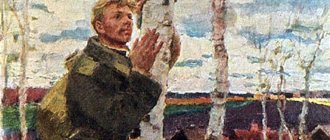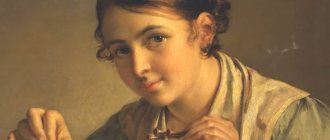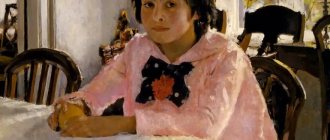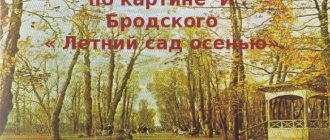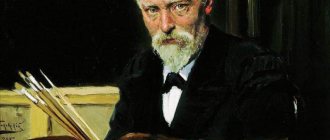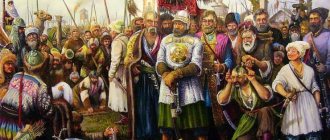Preparing to write an essay based on Shishkin’s painting “Rye”.
A brief history of the creation of the painting “Rye”
The artist made a sketch for the painting in 1877 during a trip to Yelabuga. On Lekarevsky Field he made a pencil sketch, which in 1878 formed the basis for the painting “Rye”.
Shishkin. Sketch for the painting “Rye”
Shishkin wrote about the concept of his painting:
“Expansion, space, land. Rye. God's grace. Russian wealth."
Description of the painting “Rye”.
Read the descriptions of the painting “Rye”, pay attention to the figurative descriptions, you will need them for your own essay. Underline the words that help to accurately represent the corner of nature depicted in the picture.
DESCRIPTION 1
“Abundant and mighty Rus' spreads out before us. Expanse, space, an immense golden field of rye. It sways and makes noise easily, like the sea on a clear day. A road winds through a boundless field, running into the distance, towards the horizon, paving the way to giant pine trees. They decorate the landscape. Their mighty slender trunks and heavy dark green crowns rise majestically above the field. The bright velvety greenery of the road where the swallows frolic highlights the golden tones of the rye in the sunny glow of the day. The picture is filled with a great feeling of love for the native land and its nature.”
DESCRIPTION 2
Far, far away, as far as the eye can see, stretches a golden rye. Tall old pines stand among the plain.
And this makes the expanse of the grain field even wider. The sun shines brightly. A warm breeze sways the ears. Disappears in the rye, the road calls for you.
The vast expanse!
But the painter also noticed a modest wildflower on the side of the road. And two swallows swiftly gliding just above the ground.
Did Ivan Ivanovich Shishkin just want to talk about a sunny summer day?
He dreamed that near his painting people would feel how great, rich and affectionate their native land is - the Motherland.
It is not for nothing that in one drawing he noted for himself: “Expansion. Space. Rye. Russian wealth".
According to V. Porudominsky
Selection of words to describe the picture
Now it would be nice to choose the words for your future essay. We started this thing, you can add your own ideas.
| rye | Golden, sunny, bright, light, shining, wavering like the sea, endless, rich, generous |
| ears of corn | Thin, brittle, obese, long, bending towards the ground |
| path | Overgrown, runs away, gets lost in the rye |
| pine trees | Huge, mighty, like giants, their crowns reaching into the sky, supporting the sky, ancient, majestic, heroic |
| sky | Blue, high, pure, clear, light, transparent, deep |
| impressions of the picture | The grandeur of native nature, space and power, heat, tranquility, freedom |
Questions about the painting
Answer the questions orally. This will help you in writing your essay.
- What time of year did the artist show?
- What did the author depict in the picture?
- Why does the golden field of rye occupy the main place in the picture?
- What did the artist want to convey (express) with this painting?
- What colors does I. I. Shishkin use to depict a rye field, pine trees, and sky? Why?
- What especially attracted your attention in the picture? How does it make you feel?
Rye, rye, field road...
Shishkin’s painting “Rye” is a classic reflection of the Russian national chronotope. What does he represent? The smooth surface of fields or steppe and the road stretching into the distance. The space is expanded; it is not limited by mountains or any buildings. And above him is the same wide, endless sky, whitish-blue, with clouds floating thoughtfully. And like links connecting both elements - earth and air - trees, raising their crowns upward. This is exactly what Shishkin’s painting “Rye” looks like. It was written in 1878, after another trip to his native Yelabuga. Spectators saw the painting at the 6th exhibition of the Itinerants - and were captivated by its simple, majestic beauty and sincerity. What did they see? A narrow road overgrown with grass leading forward from the viewer, paved by peasant carts between a golden rye field. The field is earing on the right and left sides, low, thick, it seems that you can hear the rustling of the ears under the breeze.
Examples of essays based on Shishkin’s painting “Rye”.
Essay based on Shishkin’s painting “Rye” - option 1.
In front of me is a painting by the Russian artist Ivan Ivanovich Shishkin “Rye”.
The main place in the picture is occupied by a rye field. It stretches to the very horizon. This is how Shishkin conveyed the expanse, space, and Russian wealth. The rye bursts with golden fire, basks under the bright sun and rustles in the quiet wind, as if talking to it. Disappears in the rye and the road calls for you. And in the background there are tall, mighty old pines. They rise majestically among the grain fields and rise to the blue sky.
I like this picture. Looking at it, I fell in love with our Russia, its nature, vastness and beauty even more.
Essay based on Shishkin’s painting “Rye” - option 2.
Painting by I.I. Shishkin's "Rye" was written in 1878.
In the foreground of the picture is a country road that goes into a golden field. The picture also depicts mighty pine trees. They stand like giants in the middle of the field. The sky took up most of the landscape. It is soft blue, with snow-white clouds floating across it. A gentle light breeze blows through a golden field of rye, bending the ripe ears to the ground. You can hear grasshoppers chirping in the grass. Somewhere in the pine trees a cuckoo is calling. Birds fly over the field, collecting grains.
Painting by I.I. Shishkina is beautiful and I really liked her. The artist managed to convey the beauty of the Russian field.
Essay based on Shishkin’s painting “Rye” - option 3.
Ivan Ivanovich Shishkin is a famous Russian artist. The painting “Rye” was painted by Ivan Ivanovich in the middle of summer 1878. This canvas depicts the wealth of the Russian land - rye.
In the foreground we see a huge field of golden rye. The grain in the ears is already ripe. The weight of the ears bends towards the ground.
A winding country road runs through the field. This road is not often traveled; half of it is covered with dark green grass, and in places you can see snow-white field daisies. In the picture we see pine trees. They look like guards guarding the rye.
The picture exudes calm and tranquility. I want to stand in front of it for hours and peer into the distance.
The great artist Ivan Ivanovich Shishkin entered the history of Russian painting as the creator of the “mood landscape”. He very skillfully conveyed the state of nature and the surrounding world through his canvases. The main character in the paintings of the master brush I. I. Shishkin are landscapes depicting forests, mainly pine. His paintings glorify the nature of his native land, the wealth and wealth of the people living on it. The landscape painting “Rye”, created by the singer of Russian nature in 1878, is imbued with a sense of peace and is executed in a bright painting style.
In the main plan of the picture, a golden field with ripe rye opens. The plump ears of corn, ready for harvest, sway in the gentle breeze. And in some places, especially along the side of the road, many golden ears of corn bent to the ground under their weight. The slight swaying of the ears conveys the aroma of a ripe harvest. There, in the depths of the field, you can see blue dots of cornflowers, which unusually decorate the entire landscape. In the foreground of the picture, a winding field road originates. It is not traveled very often; most of it is overgrown with field grass and decorated with white daisies. She, wriggling, goes into the distance deep into the field.
In a rich rye field, along a winding road, there are mighty sentinel pines. The shaggy branch of an old pine tree on the right hangs very low over the rye. On the one hand, it is completely without branches, apparently for many years it was influenced by the cold northern wind. And the trees on the left fully convey the variety of their clothes: from the most magnificent form, completely dressed in branches, to a completely bare pine, of which only the trunk remains. In the sky, above the hero pines, field birds dance their beautiful dance, enjoying a wonderful warm day. Above them, light air clouds glide across the sky. And there, in the depths of the picture, in its farthest plan, clouds can be seen, perhaps a thunderstorm is brewing and warm summer rain will soon fall.
The picture is filled with a high feeling of love for the native land and its nature. She conveys this feeling to the viewer and gives pleasure to the beautiful creation of the great master of the brush.
Everyone has long gotten used to the idea that bread comes to our homes from the store, but before everything happened completely differently. In order for bread to appear on the table, it was necessary to sow rye, take care of it, harvest it - and only then would it be possible to bake fresh, aromatic bread from flour. Probably due to the complexity of the process of obtaining bread, he was considered the head on the table and was highly valued.
Shishkin’s painting “Rye” depicts an endless field of rye that goes beyond the horizon. It seems that in the distance the rye and the sky merge into one whole and complement each other. To depict rye, the author chose a yellow, golden hue. It is associated with the sun and gold, so the field appears golden and precious. Between the fields there is a road that goes off into the distance and gets lost between the ripe ears of corn.
The artist showed that the field is watched over by silent guards - trees. They rise like dark islands above the golden field and seem to report to the sky that they are ready to harvest. Everything that happens is observed by a clear, carefree sky, which helps the precious ears ripen as quickly as possible.
I liked the picture for its simplicity and originality. If you take a closer look at this canvas, it becomes clear that the artist created a picturesque hymn to hard work and the harmony of the surrounding world.
Essay based on the painting “Rye” by I.I. Shishkin.
In front of me is a painting by the great master of painting - I.I. Shishkin, which is called “Rye”. In many of his works we see picturesque corners of our country, which he lovingly captures on his canvases.
In the foreground we see a huge field sown with rye, it is already ripe, its ripe ears are slowly swaying due to a light breeze. Some have already sank to the ground; they can no longer hold on due to the weight of the grains. They give off a delicate aroma. We also see a winding road that leads into the distance, into the depths of the field. Rarely does anyone drive along it, because it has begun to be overgrown with flowers, among them one can see blue flowers and snow-white daisies that decorate the golden field.
Behind the field there is a pine forest; powerful giant pines guard the rich harvest. There are not so many pines, and they are all different, there are pines with rich fluffy branches, and there are also very thin pines, almost without branches. One, a fluffy pine, tilted its lower branches so close to the ears of corn that it was about to crush them with its weight.
The day depicted in the picture is clear and warm, the sky is light, light, almost without clouds, almost no wind. You can clearly hear the chirping of birds flying over the field; somewhere in the distance you can see small dark clouds; they will probably soon bring warm rain.
The majesty and beauty of Russian nature is accurately described by the great artist; he paints his picture with great love for the Motherland, and ascribes every detail with tenderness and accuracy. Looking at the picture, you enjoy the artist’s skill and talent.
Essay based on Shishkin’s painting “Rye”
Ivan Ivanovich Shishkin is undoubtedly the strongest among Russian landscape painters. Looking at his painting “Rye”, you notice that the artist with a subtle understanding reproduces plant forms: both the main objects and the smallest features of the tree species, ears of rye.
Without understatement, but also without embellishment, the artist in his work reflected the climate in which the central plants of the picture have to survive - these include harsh, windy, frosty winters; this and the hot summer midday heat. But it is thanks to Shishkin’s brush in the painting “Rye” that we understand how difficult it is not only for the worker caring for the future harvest, but also how the harvest itself strives not to fall under the weight of the grains that have ripened with such difficulty.
Trees growing in a field create a dual impression: they seem to interfere with harvesting, but they also seem to provide shade for rest during harvesting. Another thought creeps in when looking at the trees: isn’t it Russian laziness that’s preventing these trees from being cut down? After all, one of them has clearly not been feeding on the juices of the earth for a long time - it has dried up.
A flock of birds is barely visible in the background. Who are these - rooks, crows, pigeons? It is clear that these are quite large birds that want to feast on ripe, aromatic grain. Why did the author depict them in his painting? Perhaps in order to express their dissatisfaction with those who use the fruits of other people's labor, but are not ready to advance one iota for their own good.
A heavy sky on the horizon is most likely not a harbinger of rain, but a harbinger of a dust storm: at this time of year (most likely August-September) the humidity is very low, so the wind also threatens the fields ready for harvest. But from the border of the horizon the eye still slides to the golden blanket of ears of corn - they seem to be about to sigh heavily. Shishkin drew each spikelet so clearly that it seems as if the grains are about to fall out of the picture!
In addition to feeling the weight of the ears of corn, you involuntarily begin to realize that you catch the smell of the field, the smell of the dust caught by the chariot (the road dividing the field into two parts indicates its need for people), the aroma of wild flowers (there are few of them, but they are an integral part of any cultivated plot of land) .
In conclusion, I would like to say that Shishkin’s painting “Rye” combines not only the science of forms, but also the science of color, becoming a strong and harmonious composition. This hymn to hard work on canvas will carry through the centuries the love of Russian people for the land and its gifts. Essay based on Shishkin’s painting “Rye”, grades 6-7
I.I. Shishkin is a great landscape painter. The paintings he created are filled with peace and amazing harmony. The artist’s canvases glorify the nature of his native country.
A distinctive feature of the painter’s works is the detailing of the plant world. He managed to convey grass, flowers, spruce, and pine trees with amazing accuracy. The artist depicted the unusual interweaving of branches, the color and structure of the soil as if they were captured in a photograph.
The painting “Rye” was painted by the painter in 1878. The idea of its creation appeared during one of the artist’s visits to his native Yelabuga.
In the foreground of the picture is a winding road stretching beyond the horizon. Rye is earing along it, slightly falling to the ground. The endless golden field is guarded like heroes by mighty pine trees, acting as a symbol of the greatness of the country. These trees invariably accompany all the paintings created by the painter. Their intricately curved trunk, branches bending to the ground under their own weight and tops reaching towards the sky were painted with special love.
The vast field of rye almost merges with the horizon, the outlines of which are visible in the haze. Cumulus clouds are gathering above him. They are driven by a light breeze that sways the ears. A thunderstorm is approaching, bringing with it a beneficial and cleansing downpour. The canvas depicts a hot day, but there is no sweltering heat that can spoil the impression of the landscape. The picture seems to invite the viewer to plunge into the endless expanses of golden fields.
Very soon the harvest will ripen and people will gather in the field to harvest it. Laughter, songs and jokes will be heard. But now there is silence on the field.
The painter managed to combine a rye field, a road track crossing it, soft and silky, bright green grass and tall pine trees. The viewer can only guess how these trees got there. Perhaps there was once a pine forest where the field is located, but man needed the land to grow bread, so he cut down the trees.
The picture is filled with peace and tranquility. Everything in this landscape is harmonious. However, against the backdrop of a sunny, warm day, a lonely dried pine tree stands out. There is no reliable information about why the artist depicted her on the canvas. Probably, this dead tree symbolizes the personal tragedy of the painter, who lost several close people in a short time.
Separately, you should dwell on the color scheme of the picture. The canvas simultaneously combines rich and pastel shades. Rye, which has a rich golden color, emerald grass, and dark green tree crowns are depicted by the artist against a soft blue sky.
The painting “Rye” is a masterpiece comparable to a poem glorifying the native land. The canvas is filled with light and life, symbolized by rye. It is from it that bread is made, which provides energy for existence.
All of the artist’s works were painted from life. This picture is no exception. The painter managed to convey the scope and grandeur of Russian nature as convincingly and truthfully as possible. The artist's work occupies a special place in landscape painting of the 19th century. His subtle perception of nature turned out to be in tune with the worldview of the common people. Perhaps this is what contributed to the fact that the painting gained the love of not only art connoisseurs, but also ordinary viewers.
I. I. Shishkin’s painting “Rye” serves as another confirmation of how majestic and rich in original landscapes our country is. The author's love permeates every natural phenomenon depicted.
The foreground is represented by a wide sandy road, smoothly turning into a narrow path hiding in the thickets of golden rye. Grass spreads underfoot, in some places having lost its lush greenness due to the heat. Small wildflowers, snow-white daisies and yellow dandelion heads are turning blue, which you just want to collect in a bouquet. Frisky swallows seem to tease, flying very low above the ground. They tirelessly remind you of the upcoming rain after hot weather.
The central place of the canvas is occupied by a field in which, as if by order of a magic wand, thousands of ripe ears of rye leaned in one direction. The background is occupied by several not young pines. They represent a powerful force, as if they have concentrated experience and wisdom. The majestic trees are hung with heavy branches with thick needles, which in some places touch the ground. Mountains are barely visible on the horizon through a light haze. A flock of dark birds soars scattered under the skies, waiting for the weather to change. There is a blue sky overhead, it is calm and cloudless. Closer to the horizon, huge shafts of clouds clustered together, as if on the eve of the first rumbles of thunder. The celestial distances are a little darker, this is where the change in atmosphere occurs.
The artist’s choice of golden paint for the rye, a not bright background for the grass slightly burnt in the sun, the dark tone of the pine needles beloved by I. I. Shishkin - all this is part of each of us, since we can easily imagine the hot air of open spaces, the coolness of coniferous trees, the chirping of insects in the grass and the singing of birds somewhere high above the ground. Each of these moments is unforgettable, especially looking at the painting of this artist. The author of the work takes the viewer of the landscape with him into the world of reality, reminding that in every little detail one can consider moments dear to the heart.
One gets the feeling that peace, happiness, and awe from the fact that we live in such a wonderful land have spread across this field.
Looking at the artist’s work with emotion, I would like to express gratitude to him for the opportunity to admire the boundless expanses of his native land at any time. The familiar feeling of waiting for rain does not leave me. Hot sand, warm rye, tired pine trees - everything seemed to freeze in a trembling premonition of coolness.
Briefly about the Russian artist Ivan Shishkin
Ivan Ivanovich Shishkin is the greatest Russian painter of the 19th century.
Ivan Ivanovich Shishkin (1832-1898)
He was born in a small town called Yelabugu in the family of a merchant.
The boy was drawn to art from early childhood, and at the age of 13 he painted his first painting, “Pine on a Rock.”
Ivan Shishkin is the creator of the well-known works “Morning in a Pine Forest” and “Rye”.
Popular writings
- Raskolnikov's essay in the novel Crime and Punishment (Image and Characteristics)
The novel Crime and Punishment was written in the mid-nineteenth century by the great writer F. M. Dostoevsky. It is a very psychological and at the same time philosophical work. - The theme of love in Bunin's work - essay
For the classic of Russian literature, Nobel Prize winner Ivan Alekseevich Bunin, the theme of love is one of the main ones in his work. Stories about love are combined into a book under the general title “Dark Alleys” - Analysis of the story The Wonderful Doctor Kuprin
A Christmas story was published in 1897. Alexander Ivanovich heard it from the lips of a banker friend, a wonderful, honest man.
The history of the painting
The idea to paint the painting “Rye” came to the mind of the artist Shishkin when he and his daughter arrived in Yelabuga. There he spent a lot of time with his sister in the fields that were strewn with rye.
Inspired by this view, the artist made a plan of the area, and soon created a reproduction of the house.
Option 4
The work, first unveiled during a traveling exhibition, at the same moment was reliably established among the public and unique images of Russian nature. Nowadays it is extremely difficult to find a painting of similar fame related to the landscape of Russia.
Shishkin concluded in the presented work the main tones of Russian fine art, which are always used in painting icons: blue and golden yellow. This is the simple secret of success. The colors of the Orthodox relics juxtapose the picture with the world, divine and eternal. This symbolic combination unites the nature of Russia with the divine.
The greenery growing densely along the edges of the field completes the palette of the work in the same way as the tops of the pine trees in the far part of the picture. The symbolic meaning of the trees gives the meaning of the painting vitality, fortitude and aspiration. The trees in the picture are embodied by heroes from legends guarding the field.
The opposite is a dead, stunted tree. Through this tree, the author conveyed a personal tragedy, known to those who are familiar with his biography, since before painting the picture, the artist said goodbye to his dear people. He was left behind by two children, his wife and father. The dramaturgy, emotional line and symbol of the author in this picture bring the viewer closer to the work. What is displayed on the canvas is filled with the atmosphere of summer with its heat and thirst for moisture. The country road neatly divides the field into unequal halves, bringing energy to the picture, and the people add unique interest to the landscape.
Two seemingly small people represent the entire size and vastness of Russian nature in comparison with themselves. Clouds barely visible on the horizon, full of grandeur and moisture, carry coolness and light. Everything that is depicted in the picture, from the rye field and grass to each ear of corn, is ready to absorb rainwater. The atmosphere of the work helps the viewer to hear the symphony of a summer field: the buzzing and rustling, chirping and cries of swallows.
2, 4, 6, 8 grade

